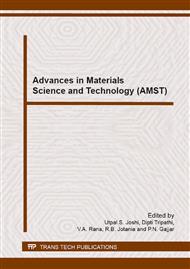[1]
D.W. Bullett, Bulk and surface electron states in WO3 and tungsten bronzes, J. Phys. C: Solid State Phys. 16 (1983) 2197- 2207.
DOI: 10.1088/0022-3719/16/11/022
Google Scholar
[2]
F. Cora, A. Patel, N.M. Harrison, R. Dovesi, C.R.A. Catlow, An ab initio Hartree-Fock study of the cubic and tetragonal phases of bulk tungsten trioxide, J. Am. Chem. Soc. 118 (1996) 12174-12182.
DOI: 10.1021/ja961514u
Google Scholar
[3]
F. Cora, M.G. Stachiotti, C.R.A. Catlow, C.O. Rodriguez, Transition metal oxide chemistry: Electronic structure study of WO3, ReO3, and NaWO3, J. Phys. Chem. B 101 (1997) 3945-3952.
DOI: 10.1002/chin.199731003
Google Scholar
[4]
G.A. de Wijs, P.K. de Boer, R.A. de Groot, G. Kresse, Anomalous behavior of the semi-conducting gap in WO3 from first-principles calculations, Phys. Rev. B 59 (1991) 2684-2693.
DOI: 10.1103/physrevb.59.2684
Google Scholar
[5]
C.J. Howard, V. Luca, K.S. Knight, High-temperature phase transitions in tungsten trioxide-the last word?, J. Phys.: Condens. Matter 14 (2002) 377-387.
DOI: 10.1088/0953-8984/14/3/308
Google Scholar
[6]
C. Lambert-Mauriat, V. Oison, Density-functional study of oxygen vacancies in monoclinic tungsten oxide, J. Phys.: Condens. Matter 18 (2006) 7361-7371.
DOI: 10.1088/0953-8984/18/31/028
Google Scholar
[7]
K. Masek, J. Libra, T. Skala, M. Cabala, V. Matolin, V. Chab, K.C. Prince, SRPES investigation of tungsten oxide in different oxidation states, Surf. Sci. 600 (2006) 1624-1627.
DOI: 10.1016/j.susc.2005.11.048
Google Scholar
[8]
M.R. Field, D.G. McCulloch, S.N.H. Lim, A. Anders, V.J. Keast, R.W. Burgees, The electronic structure of tungsten oxide thin films prepared by pulsed cathodic arc deposition and plasma-assisted pulsed magnetron sputtering, J. Phys.: Condens. Matter 20 (2008) 175216-1 to 7.
DOI: 10.1088/0953-8984/20/17/175216
Google Scholar
[9]
M.N. Huda, Y. Yan, C.-Y. Moon, S.-H. Wei, M.M. Al-Jassim, Density-functional theory study of the effects of atomic impurity on the band edges of monoclinic WO3, Phys. Rev. B 77 (2008) 195102-1 to 13.
DOI: 10.1103/physrevb.77.195102
Google Scholar
[10]
R. Dovesi, V.R. Saunders, C. Roetti, R. Orlando, C.M. Zicovich-Wilson, F. Pascale, B. Civalleri, K. Doll, N.M. Harrison, I.J. Bush, Ph. D'Arco, M. Llunell, CRYSTAL2009 User's Manual, University of Torino, Torino, Italy, 2009.
Google Scholar
[11]
P. Blaha, K. Schwarz, G.K.H. Madsen, D. Kvasnicka, J. Luitz, WIEN2k, An augmented plane wave plus local orbitals program for calculating crystal properties, Vienna University of Technology, Vienna, Austria, 2001.
Google Scholar
[12]
Y. Zhao, D.G. Truhlar, Construction of a generalized gradient approximation by restoring the density-gradient expansion and enforcing a tight Lieb-Oxford bound, J. Chem. Phys. 128 (2008) 184109-1 to 8.
DOI: 10.1063/1.2912068
Google Scholar
[13]
J. P. Perdew, K. Burke, M. Ernzerhof, Generalized gradient approximation made simple, Phys. Rev. Lett. 77 (1996) 3865-3868.
DOI: 10.1103/physrevlett.77.3865
Google Scholar
[14]
T. Bak, J. Nowotny, M. Rekas, C.C. Sorrell, Photo-electrochemical hydrogen generation from water using solar energy. Materials related aspects, Int.J. Hydrogen Energy 27 (2001) 991-1022.
DOI: 10.1016/s0360-3199(02)00022-8
Google Scholar


